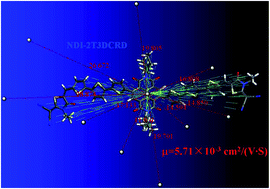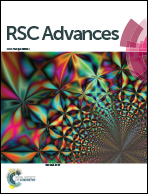Theoretical investigations of the small molecular acceptor materials based on oligothiophene – naphthalene diimide in organic solar cells†
Abstract
A series of novel acceptor–donor–acceptor–donor–acceptor (A2–D–A1–D–A2) structured acceptor oligomers with naphthalene diimide (NDI) as centre and acceptor unit (A1), oligothiophenes (T = 1, 2, 3, 4) as π-bridges (D), and 2-(1,1-dicyanomethylene)rhodanine (DCRD) as terminal groups (A2) have been investigated using quantum chemistry and Marcus theory in this research. Compared with NDI-2T1Me—NDI-2T4Me, the NDI-2T1DCRD—NDI-2T4DCRD exhibit stronger and wider absorption peaks because of the increase of the electron withdrawing ability of the electron deficient units. In particular for the NDI-2T3DCRD, the electron mobility (μe = 5.71 × 10−3 cm2 V−1 S−1) was accurately predicted quantitatively using first principle simulation. The blend of poly(3-hexylthiophene) with NDI-2T3DCRD as an active layer exhibits obviously strong and wide light absorption, which form a perfectly complementary absorption. The results indicate that the incorporation of DCRD as acceptor units into D–A–D type oligomers has been proven to create promising candidates for high efficiency acceptor materials for organic solar cells (OSCs). Overall, this research may provide a theoretical guidance for designing small molecular acceptors for OSC applications.



 Please wait while we load your content...
Please wait while we load your content...